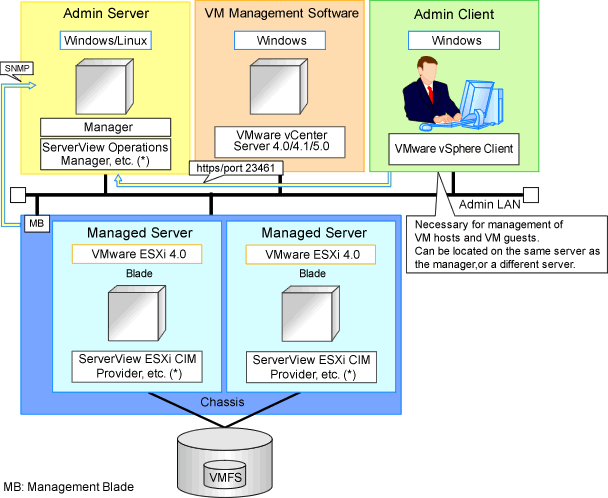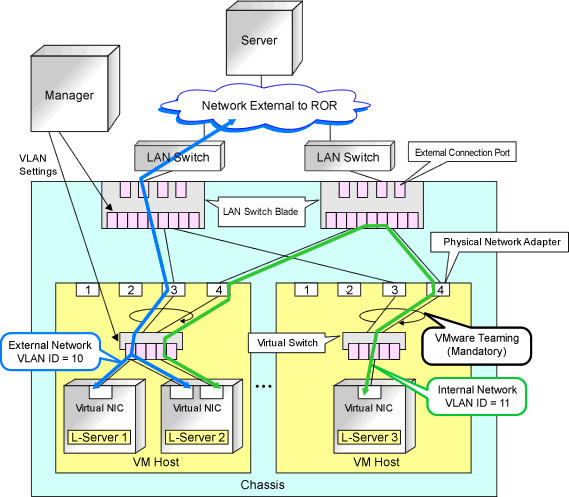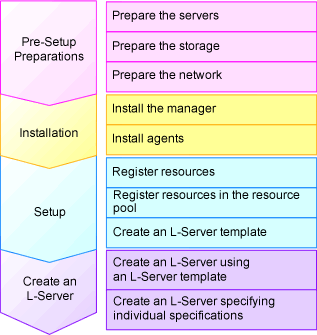This section how to configure VMware for use as server virtualization software.
Example of System Configuration
An example system configuration using VMware ESX is given below.
Figure E.1 System Configuration Example Using VMware ESX

* Note: For details of the required software, refer to "6.1.2.4 Required Software" in the "Overview".
An example system configuration using VMware ESXi is given below.
Figure E.2 System Configuration Example Using VMware ESXi

* Note: For details of the required software, refer to "6.1.2.4 Required Software" in the "Overview".
An example system configuration for deploying VMware ESXi using Auto Deploy is given below.
Figure E.3 Example of System Configuration for Installing VMware ESXi Using Auto Deploy

* Note: For details of the required software, refer to "6.1.2.4 Required Software" in the "Overview".
Note
For a configuration example for rack mount servers, delete the chassis and management blades from the diagram above.
Simplifying network settings
Network settings can be easily configured by Resource Orchestrator when creating L-Servers.
Depending on the conditions, such as hardware (blade servers or rack mount servers) and the presence or absence of network redundancy for L-Servers, the setting ranges of networks differ.
For details, refer to "2.2.7 Simplifying Networks" and "9.4 Preparations for Resource Orchestrator Network Environments".
Network Configuration Example
An example network configuration using VMware is given below:
Figure E.4 LAN Switch Blade and Virtual Switch Configuration Using Network Resources [VMware]

Note
When network settings have been performed automatically for an L-Server in a VMware environment, redundancy of virtual switches and physical network adapters will be performed using VMware Teaming.
For Resource Orchestrator, configure the LAN switch blades when using switch mode or end-host mode.
Configure the admin and public LANs as physically separate. For details, refer to "Chapter 9 Defining and Configuring the Network Environment".
L-Server Creation Procedure
Use the following procedure to create L-Servers:
Figure E.5 Resource Orchestrator Setup Procedure

For details on pre-setup preparations, refer to "E.1 VMware".
For details on how to install Resource Orchestrator, refer to "Chapter 2 Installation" in the "Setup Guide CE".
For details on how to set up Resource Orchestrator, refer to "8.2 VMware" in the "Setup Guide CE".
For details on how to create an L-Server, refer to "8.2.7 Creating L-Servers" in the "Setup Guide CE".
Point
When Using VMware ESX
Install Resource Orchestrator agents and ServerView for VMware agents.
When Using VMware ESXi
Install ServerView ESXi CIM Provider.
When using VMware ESXi on another vendor's servers or when not using ServerView ESXi CIM Provider on VMware ESXi on Fujitsu rack mount servers, perform the definition is "8.1.5 Definition Files when Creating a Virtual L-Server Using VMware ESXi on Another Vendor's Servers or when Creating Virtual L-Servers without Using ServerView ESXi CIM Provider on VMware ESXi on Fujitsu Rack Mount Servers" in the "Setup Guide CE".
When Using Windows Server 2012 R2 or later as a Guest OS
Refer to the following and configure the settings of the SCSI controller before creating virtual L-Servers.
"SCSI Controller Definition File" in "8.2.1 Creating Definition Files" in the "Setup Guide CE"